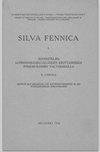挪威林业林分水平情景模型——气候变化下森林管理的案例研究
IF 1.8
3区 农林科学
Q2 FORESTRY
引用次数: 0
摘要
固碳和创收是现代森林管理中相互竞争的目标。许多国家的气候承诺依赖森林作为碳汇,必须对其进行量化、监测和对未来的预测。在预测方面,我们需要工具来模拟森林发展并进行情景分析,以评估不同管理制度下的未来固碳潜力、这些制度的预期净现值以及气候变化的可能影响。我们提出了一个情景分析软件工具(GAYA 2.0),它可以通过林分模拟、详细的碳流模型和优化器来帮助回答这些类型的问题。本文有两个目标:(1)描述GAYA 2.0,(2)在一个案例研究中展示其潜力,我们基于国家森林清查样地分析了挪威一个地区的森林碳平衡。该工具用于绘制碳效益和净现值之间的最优前沿。我们观察到不同碳效益水平的净现值变化以及最优管理策略的变化。我们预测了几个森林碳库以及反照率的未来变化,并说明了森林生产力逐渐增加(即由于气候变暖)的影响。GAYA 2.0比以前的版本更新和现代化,更加关注森林碳和能量通量,是一个有效的工具,为在森林管理中进行各种类型的情景分析提供了多种机会。本文章由计算机程序翻译,如有差异,请以英文原文为准。
A stand level scenario model for the Norwegian forestry – a case study on forest management under climate change
Carbon sequestration and income generation are competing objectives in modern forest management. The climate commitments of many countries depend on forests as carbon sinks which must be quantified, monitored, and projected into the future. For projections we need tools to model forest development and perform scenario analyses to assess future carbon sequestration potentials under different management regimes, the expected net present value of such regimes, and possible impacts of climate change. We propose a scenario analysis software tool (GAYA 2.0) that can assist in answering these types of questions using stand level simulations, detailed carbon flow models and an optimizer. This paper has two objectives: (1) to describe GAYA 2.0, and (2) demonstrate its potential in a case study where we analyze the forest carbon balance over a region in Norway based on national forest inventory sample plots. The tool was used to map the optimality front between the carbon benefit and net present value. We observed changes in net present value for different levels of carbon benefit as well as changes in optimal management strategies. We predicted future changes in several forest carbon pools as well as albedo and illustrated the impact of gradual increase in forest productivity (i.e., due to climate warming). Having been updated and modernized from its previous version with increased attention to forest carbon and energy fluxes, GAYA 2.0 is an effective tool that offers multiple opportunities to perform various types of scenario analyses in forest management.
求助全文
通过发布文献求助,成功后即可免费获取论文全文。
去求助
来源期刊

Silva Fennica
农林科学-林学
CiteScore
3.50
自引率
11.10%
发文量
21
审稿时长
3 months
期刊介绍:
Silva Fennica publishes significant new knowledge on forest sciences. The scope covers research on forestry and forest ecosystems. Silva Fennica aims to increase understanding on forest ecosystems, and sustainable use and conservation of forest resources. Use of forest resources includes all aspects of forestry containing biomass-based and non-timber products, economic and social factors etc.
 求助内容:
求助内容: 应助结果提醒方式:
应助结果提醒方式:


